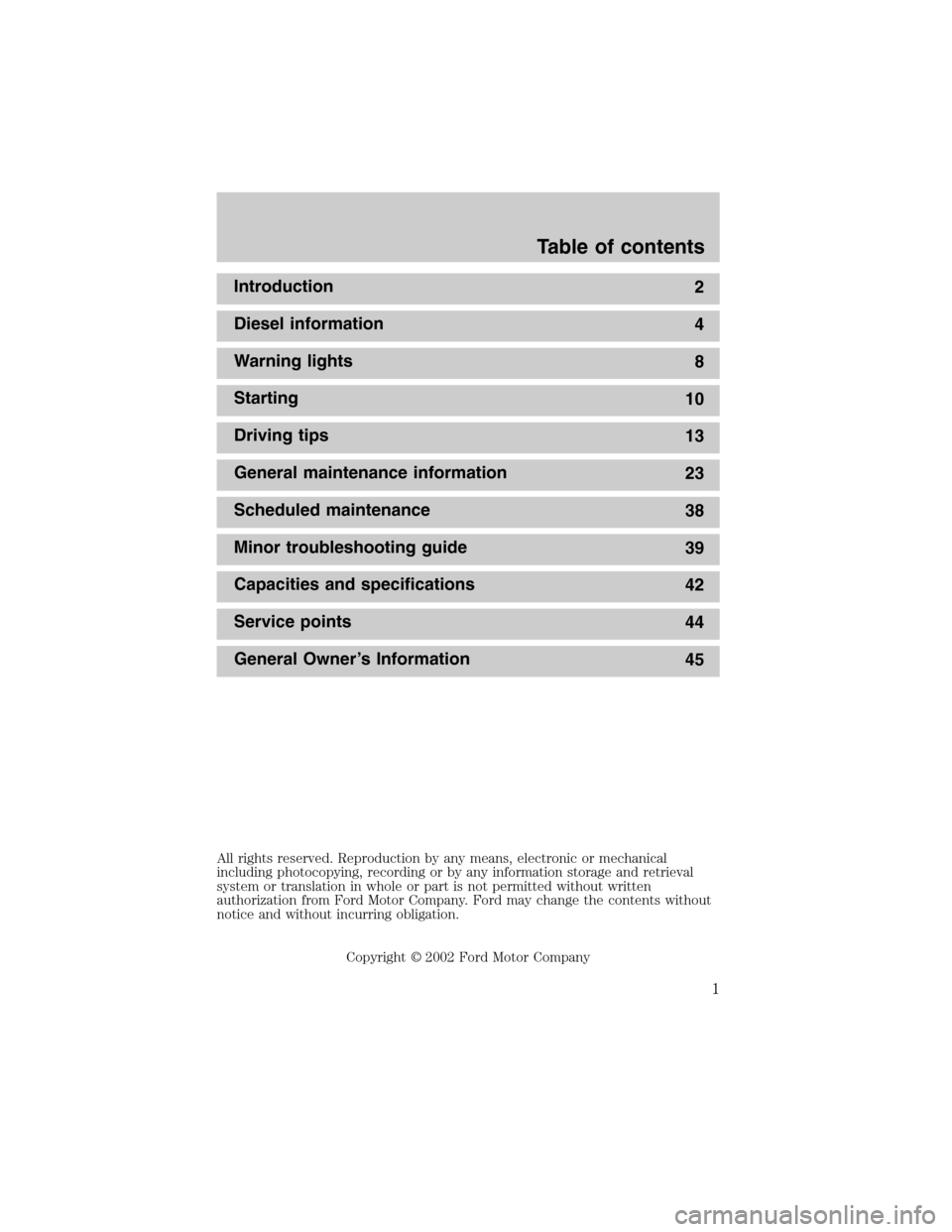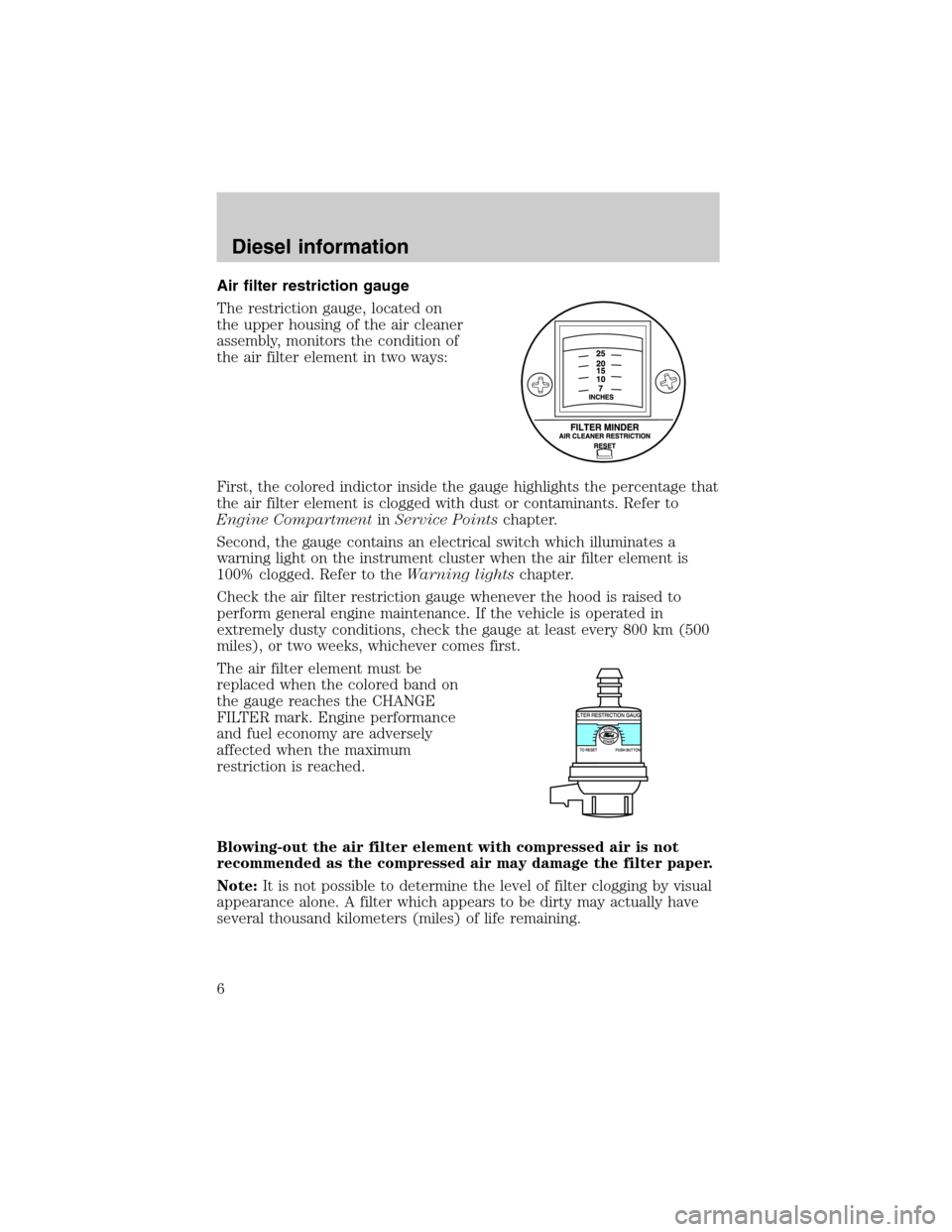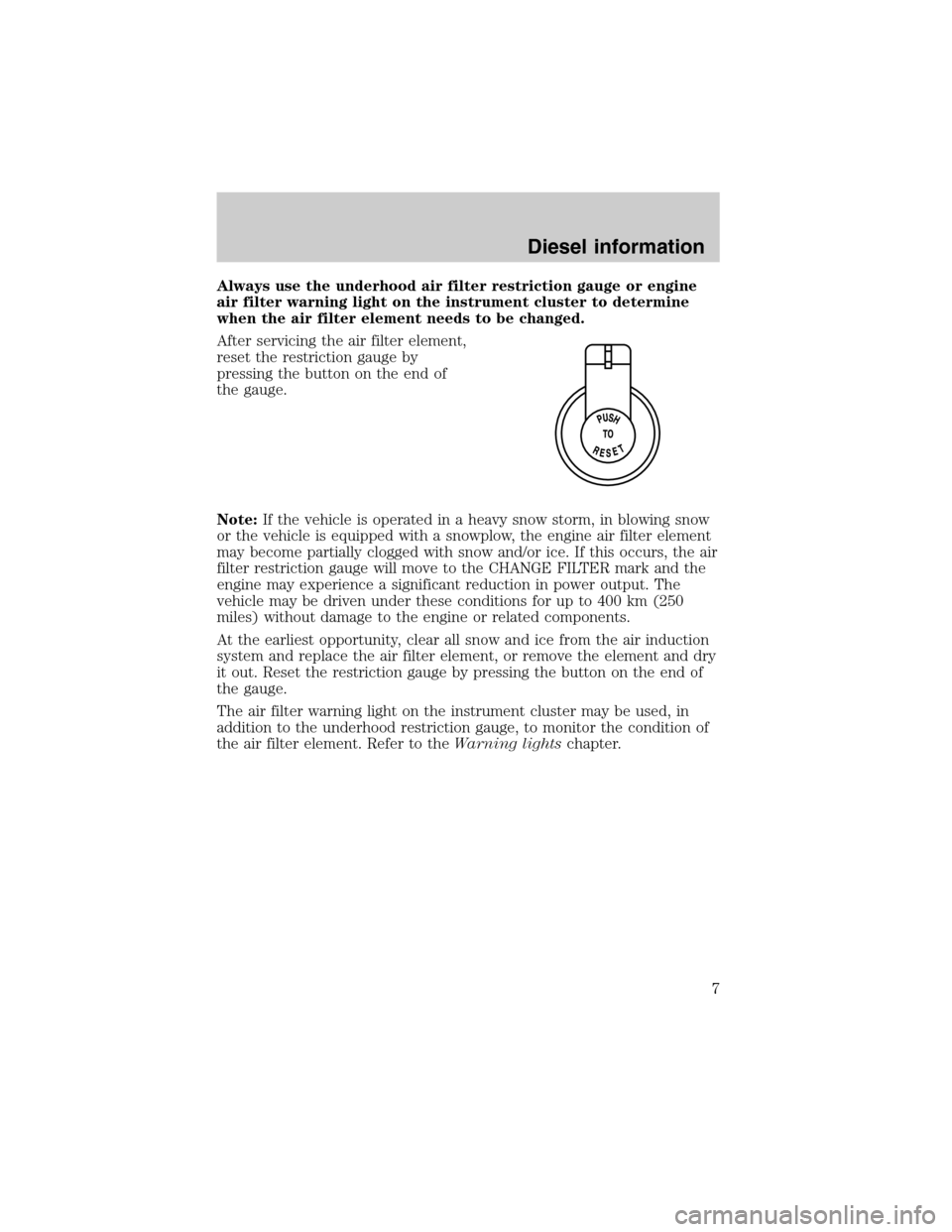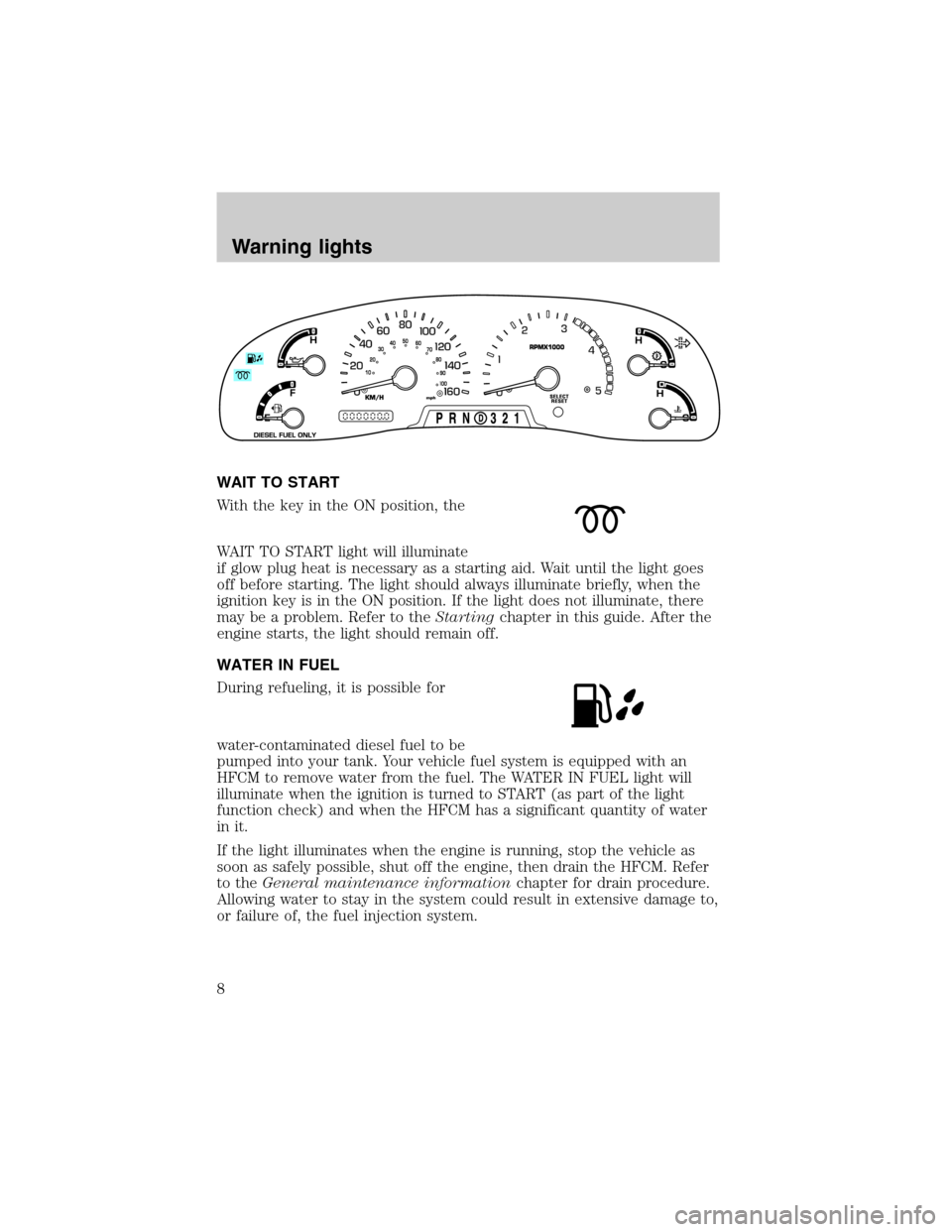2003 FORD SUPER DUTY warning
[x] Cancel search: warningPage 1 of 64

Introduction
2
Diesel information
4
Warning lights
8
Starting
10
Driving tips
13
General maintenance information
23
Scheduled maintenance
38
Minor troubleshooting guide
39
Capacities and specifications
42
Service points
44
General Owner’s Information
45
All rights reserved. Reproduction by any means, electronic or mechanical
including photocopying, recording or by any information storage and retrieval
system or translation in whole or part is not permitted without written
authorization from Ford Motor Company. Ford may change the contents without
notice and without incurring obligation.
Copyright © 2002 Ford Motor Company
Table of contents
1
Page 2 of 64

California Proposition 65 Warning
WARNING:Engine exhaust, some of its constituents, and
certain vehicle components contain or emit chemicals known to
the State of California to cause cancer and birth defects or other
reproductive harm. Certain fluids contained in vehicles and certain
products of components contain or emit chemicals known to the State
of California to cause cancer and birth defects or other reproductive
harm.
Your new Diesel engine will feel, drive and function somewhat differently
than a gasoline engine. Therefore it is very important that you read and
thoroughly familiarize yourself and others operating the vehicle with this
guide.
This guide will acquaint you with the 6.0L Power Stroke Diesel engine. It
provides recommendations on engine care and operating procedures. For
complete vehicle information, also refer to the Owner Guide included
with the vehicle. It also describes equipment and gives specifications for
equipment that was in effect when this guide was approved for printing,
and should be considered a permanent part of the vehicle.
Some aftermarket products may cause severe engine and/or
transmission damage. There are various manufacturers offering
devices to increase turbocharger boost, exhaust brakes to
increase stopping/hauling capacity or other such devices to
increase the power/torque of the Power Stroke engine. Many
owners’ past experience with these products has been very poor.
Severe powertrain damage may result from the use of these
aftermarket products which will not be covered by the Ford
warranty.
Ford may discontinue models or change specifications without any notice
and without incurring obligations.
Introduction
2
Page 3 of 64

IMPORTANT NOTICE
Ford vehicles are suitable for producing ambulances only if equipped
with theFord Ambulance Preparation Package.In addition, Ford
urges ambulance manufacturers to follow the recommendation of the
Ford Incomplete Vehicle Manual, Ford Truck Body Builder’s Layout
Book(and pertinent supplements) and theQualified Vehicle Modifiers
Guidelines. Using a Ford vehicle without theFord Ambulance
Preparation Packageto produce an ambulance voids the Ford warranty
and could result in elevated underbody temperatures, fuel
overpressurization and the risk of fuel expulsion and fires. To determine
whether the vehicle is equipped with theFord Ambulance Preparation
Package,inspect the information plate on the driver’s side door pillar.
Contact the manufacturer of your vehicle to determine whether the
ambulance manufacturer’s followed Ford’s recommendations.
WARNINGS
Throughout this guide, you will find warnings. Warnings remind you to
be especially careful to avoid personal injury.
NEW VEHICLE BREAK-IN
Your vehicle does not need an extensive break-in. Try not to drive
continuously at the same speed for the first 1,600 km (1,000 miles) of
new vehicle operation. Vary your speed to allow parts to adjust
themselves to other parts.
Drive your new vehicle at least 800 km (500 miles) before towing a
trailer.
Do not add friction modifier compounds or special break-in oils during
the first few thousand kilometers (miles) of operation, since these
additives may prevent piston ring seating. SeeEngine oilin theGeneral
maintenance informationchapter for more information on oil usage.
Introduction
3
Page 6 of 64

Air filter restriction gauge
The restriction gauge, located on
the upper housing of the air cleaner
assembly, monitors the condition of
the air filter element in two ways:
First, the colored indictor inside the gauge highlights the percentage that
the air filter element is clogged with dust or contaminants. Refer to
Engine CompartmentinService Pointschapter.
Second, the gauge contains an electrical switch which illuminates a
warning light on the instrument cluster when the air filter element is
100% clogged. Refer to theWarning lightschapter.
Check the air filter restriction gauge whenever the hood is raised to
perform general engine maintenance. If the vehicle is operated in
extremely dusty conditions, check the gauge at least every 800 km (500
miles), or two weeks, whichever comes first.
The air filter element must be
replaced when the colored band on
the gauge reaches the CHANGE
FILTER mark. Engine performance
and fuel economy are adversely
affected when the maximum
restriction is reached.
Blowing-out the air filter element with compressed air is not
recommended as the compressed air may damage the filter paper.
Note:It is not possible to determine the level of filter clogging by visual
appearance alone. A filter which appears to be dirty may actually have
several thousand kilometers (miles) of life remaining.
Diesel information
6
Page 7 of 64

Always use the underhood air filter restriction gauge or engine
air filter warning light on the instrument cluster to determine
when the air filter element needs to be changed.
After servicing the air filter element,
reset the restriction gauge by
pressing the button on the end of
the gauge.
Note:If the vehicle is operated in a heavy snow storm, in blowing snow
or the vehicle is equipped with a snowplow, the engine air filter element
may become partially clogged with snow and/or ice. If this occurs, the air
filter restriction gauge will move to the CHANGE FILTER mark and the
engine may experience a significant reduction in power output. The
vehicle may be driven under these conditions for up to 400 km (250
miles) without damage to the engine or related components.
At the earliest opportunity, clear all snow and ice from the air induction
system and replace the air filter element, or remove the element and dry
it out. Reset the restriction gauge by pressing the button on the end of
the gauge.
The air filter warning light on the instrument cluster may be used, in
addition to the underhood restriction gauge, to monitor the condition of
the air filter element. Refer to theWarning lightschapter.
Diesel information
7
Page 8 of 64

WAIT TO START
With the key in the ON position, the
WAIT TO START light will illuminate
if glow plug heat is necessary as a starting aid. Wait until the light goes
off before starting. The light should always illuminate briefly, when the
ignition key is in the ON position. If the light does not illuminate, there
may be a problem. Refer to theStartingchapter in this guide. After the
engine starts, the light should remain off.
WATER IN FUEL
During refueling, it is possible for
water-contaminated diesel fuel to be
pumped into your tank. Your vehicle fuel system is equipped with an
HFCM to remove water from the fuel. The WATER IN FUEL light will
illuminate when the ignition is turned to START (as part of the light
function check) and when the HFCM has a significant quantity of water
in it.
If the light illuminates when the engine is running, stop the vehicle as
soon as safely possible, shut off the engine, then drain the HFCM. Refer
to theGeneral maintenance informationchapter for drain procedure.
Allowing water to stay in the system could result in extensive damage to,
or failure of, the fuel injection system.
Warning lights
8
Page 9 of 64

Do not drain the HFCM while the engine is running. Fuel may
ignite if the separator is drained while the engine is running or
the vehicle is moving.
ENGINE AIR FILTER
The engine air filter warning light
illuminates when the air filter
restriction gauge reaches the
CHANGE FILTER mark.
The vehicle may be driven with the engine air filter warning light
illuminated for up to 400 km (250 miles) without damaging the engine or
related components. However, the air filter elementmustbe replaced at
the earliest opportunity. Refer toAir filter restriction gaugein the
Diesel informationchapter for more information.
Warning lights
9
Page 11 of 64

5. After the engine starts, allow it to idle for about 15 seconds. (Do not
increase engine speed until the oil pressure gauge indicates normal
pressure.)
STOPPING THE ENGINE
Turn the ignition to OFF. To prolong engine life (after extended high
speed or maximum GVW operation), it is recommended that a hot engine
be allowed to operate at low idle for about 7–10 minutes which would
allow sufficient time for the turbocharged engine to cool down.
COLD WEATHER OPERATION
Changing to a lighter grade engine oil also makes starting easier under
these conditions. Refer toEngine oil specificationsin theGeneral
maintenance informationchapter.
At temperatures below–7°C (20°F), Number 2–D Diesel fuel may
thicken enough to clog the fuel filter. Your vehicle is equipped with an
HFCM which acts as a fuel filter/heater/water separator to keep the wax
melted which will help prevent fuel filter clogging. However, if the engine
starts but stalls after a short time and will not restart, the fuel filter(s)
may be clogged. For best results in cold weather, use Number 1–D Diesel
fuel or“winterized”Number 2–D Diesel fuel which has an additive to
minimize wax formation.
Your vehicle is also equipped with a bypass relief valve, located on the
fuel control module, which provides fuel flow to the engine if the fuel
pickup should become plugged by ice or wax. To allow this bypass valve
to function and avoid engine fuel starvation, it is recommended that,
during cold weather operation 0°C (32°F) or below, the fuel level in your
tank should not be allowed to drop below 1/4 full. This will help prevent
air from entering the fuel system and stalling the engine.
In cold weather below 0°C (32°F) your Diesel engine will slowly increase
to a higher idle speed if left idling in P (Park). As the engine warms-up,
the engine sound level will decrease due to the activation of
PCM-controlled sound reduction features.
Operation in snow
Vehicle operation in heavy snowfall or in dry loose snow that may swirl
around the front of the vehicle may feed excessive amounts of snow into
the air intake system. This could plug the air cleaner with snow and
cause the engine to stall.
Refer toAir filter restriction gaugein theDiesel informationchapter
and Engine air filter in theWarning lightschapter for more information.
Starting
11